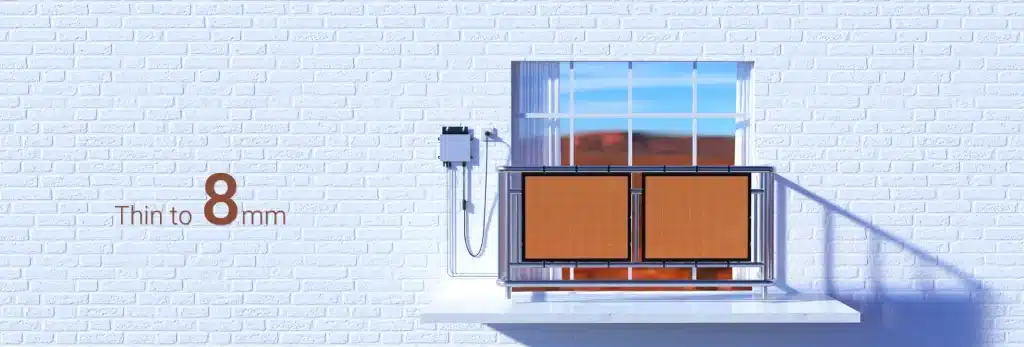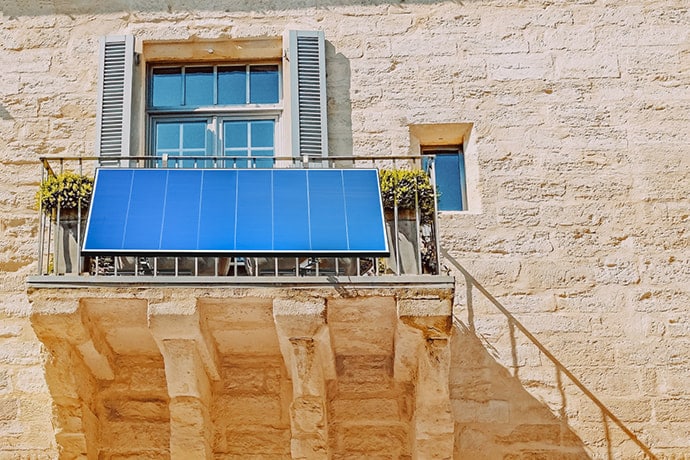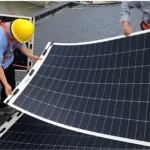What are the balcony solar systems?
The evolution of lifestyles and the scarcity of resources have led to a constant quest for sustainable energy. The sun’s unlimited energy makes this possible, but there are millions of renters and apartment owners who are overwhelmed by the inability to utilize solar energy. Typical solar installations require a large budget and a private roof. Now people can overcome these difficulties by installing solar panels on bay windows and balconies.
Balcony solar systems are becoming increasingly popular in Germany as a sustainable solution for energy production. These systems usually consist of 2 to 4 solar panels mounted outside the balcony and offer homeowners and tenants an excellent way to generate electricity and reduce dependence on the grid.
What components do you need for your balcony solar system?
A balcony solar system typically consists of balcony solar panels, an inverter, batteries, and a power management system. The purpose of a balcony solar system is to provide renewable energy by capturing sunlight and converting it into electricity for home or commercial power needs.
The main components of a balcony solar system include:
Solar Panel: This is the core component of the system and is responsible for converting sunlight into electricity. Solar panels are usually installed on the balcony to receive sunlight and generate DC electricity.
Inverter: The current generated by the solar panel is direct current (DC), whereas the household appliances we usually use require alternating current (AC). The inverter’s role is to convert the DC generated by the solar panels into AC for the appliances.
Batteries: Sometimes, when there is not enough sunlight or at night, solar panels cannot produce enough electricity. A battery storage system can be used to store the excess power generated during the day so that it can be used when needed.
Power Management System: This system is used to monitor and control the operation of the solar system to ensure maximum utilization of solar energy while protecting the system from overloads or other problems. Excess power can also be transmitted to the grid, saving individuals or families money on their electricity bills.
The exact number of solar system kits and the size of the solar system will depend on the needs of the user and how much energy they wish to generate.
These are the standard items you should expect a fully functional balcony solar system to require. Larger systems with multiple solar panels may require more microinverters than smaller systems with only one or two solar panels.
Another factor to consider is the space available to accommodate the solar PV system. If you are installing your system on a balcony, expect that you may only need one or two panels to make up the entire system.
If you are unsure of the number of components you may need or the type of setup that is appropriate for your property, then you should consult a professional before installation.

Is it worth investing in the balcony solar systems?
Easy to install
First of all, balcony solar systems are very easy to install compared to some traditional solar panel systems, which usually have many complicated wiring paths to connect.
Balcony systems, also known as plug-in solar systems, simply plug into an outlet and connect directly to your home’s electrical circuit. Users simply plug their balcony solar system into a wall outlet and start generating power, eliminating the need for costly specialized panel design and evaluation. This means complicated installations are a thing of the past for those investing in plug-in solar equipment.
No Registration Required
Additionally, balcony solar systems do not require registration with an operator like traditional rooftop or ground-mounted systems. Normally, you need to report to the operator when you connect your solar panels to the main grid. However, if your solar system is below the European upper limit of 800 W, there is no need to register with the operator.
Unlimited energy
If you happen to live in a sunny area but find yourself on a property that doesn’t support traditional solar panel systems, balcony panels are worth considering.
With rising energy prices and a growing need for sustainability, balcony solar panel systems are a worthwhile investment. A stock that could eventually pay dividends in the future. The cost of offsetting energy bills cannot be underestimated.
However, to ensure that you are making a reliable investment, it is wise to consult with professionals who can assess your property and energy needs. They can help you make an informed decision on whether this is a good investment for you.
If you’d like to learn more, or if you’re ready to talk to one of our experts about how we can help, contact us today. One of our friendly team members will be more than happy to discuss this with you.
New German Standard 800W Microinverter
In Germany, the federal government now wants to make it easier to install small solar systems. The draft law “Solarpaket I” provides for simplified registration. Click here for more details.
Another bill comes from the Federal Ministry of Justice: Tenants and apartment owners should in the future have the legal right to install power plants on their balconies. However, landlords or homeowners’ associations will be able to prohibit the installation of solar modules. For facades facing the street, residents need to obtain the consent of the landlord or homeowner’s association, as solar modules can change the visual impression of the house. However, it is advisable to notify the landlord and co-owners in advance, even if the facade is far from the street side.
There are also plans to increase the permitted inverter power to 800 watts (previously 600 watts) and to allow the use of old meters without backstops.
There is also information about the VAT, since January 2023, plug-in solar systems are exempt from sales tax, as are large PV systems.
In some municipalities, federal states, and regional associations, mini solar systems are subsidized, usually for 100 euros or more. So it’s worth asking.

How Sungold can help you build a balcony solar system kit?
Generating electricity for your consumption makes economic sense when the producer himself uses as much electricity as possible. In Sungold, you will find complete balcony solar systems, so-called balcony power plants. These systems offer you a simple way to generate sustainable solar energy on your balcony, reducing your dependence on energy suppliers and creating sustainable electricity.
The Sungold balcony solar systems are easy to install and can be mounted on your balcony to integrate the generated energy into your home’s electrical grid. By using Sungold balcony solar panels, you not only generate your electricity but also contribute to the reduction of CO2 emissions. What’s more, you can even realize a financial return by feeding excess electricity into the grid.
Start having your solar power system for your balcony today. We highly recommend: the 880W solar system with plug-and-play functionality and APP control (800w balcony PV system).
Five outstanding features
1. Aesthetic Architectural Fusion
2. Micro Inverter: 600W to 800W
3. Ultra-Thin at 8mm
4. Plug & Flex Install
5. Durable 25-Year Life
Q&A about Balcony Solar Panels
What are the considerations for installing balcony solar panels on a balcony?
A: When installing solar panels you need to consider factors such as sunlight exposure, space size, and structural load-bearing capacity. Ensure that the balcony has enough sunlight exposure time and choose the right size of solar panels, as well as ensure that the mounting structure meets safety standards.
Are balcony solar systems suitable for all regional climates?
A: The effectiveness of a balcony solar system is closely related to the sunlight hours and light intensity of the region where it is located. Generally speaking, sunny areas are more suitable for installing solar systems, but even in shadier areas, performance can still be improved by choosing high-efficiency solar panels and proper system design.
Specifically, solar modules provide optimal yield on an unshaded south-facing balcony, a garage roof, a patch of lawn or even a garden wall. One can also place them on flat or slightly sloping roofs. They are then usually not visible from the street. To make the most of the sun all year round, the panels should also be sloped to the south – the angle to the horizon should be around 30 to 40 degrees. If this position is shaded or the solar modules are not optimally aligned, the yield will drop.
What do I need to know about the maintenance of solar panels on my balcony?
A: Solar panels typically require less maintenance, but regular cleaning of dust and dirt from the surface is key to ensuring optimal performance. In addition, checking system connections and wiring for proper functioning and ensuring trouble-free operation are also important maintenance tasks.
Do balcony solar systems require additional batteries to store electricity?
A: The need for additional batteries depends on individual needs and the capacity of the solar panels. If you wish to use solar energy at night or during cloudy days, a battery storage system will be useful. Otherwise, some systems can send excess power back to the grid without the need for additional batteries.
What is the payback period for the balcony solar systems?
A: The payback cycle depends on several factors, including the cost of the system, the solar energy resources in your area, the local price of electricity, and any government incentives that may be available. Typically, the payback cycle for a balcony solar system can range from a few years to a dozen years. Sungold balcony solar panels have a 25-year lifespan.
In addition, if your consumption is correspondingly high, the payback period will be significantly shorter.







